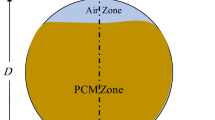Abstract
When melting processes are associated with an exothermic heat of mixing, unique coupled transport phenomena take place. In this article, a mathematical model has been developed to simulate these unique coupled heat and mass transfer events. The model was based on the control-volume finite difference approach and on an enthalpy method. In order to verify the mathematical model, a low-temperature physical model was established consisting of ice and sulfuric acid solutions. In this physical model, both temperature and velocity measurements were carried out. The model predictions were compared with experimental measurements, and they were found to be in good agreement. The model was also applied to a high-temperature system, namely, the melting of silicon metal in liquid high carbon iron. The predictions distinguished two periods present in the entire melting process. In the first period, the silicon was heated up. The second period, i.e., free melting period, occurred in tandem with the exothermic reaction, and consequently, the melting process was greatly accelerated. As was the case with the low-temperature physical model, as with the high-temperature system, good agreement was obtained between the predicted results and the experimental measurements.
Similar content being viewed by others

References
S.A. Argyropoulos and R.I.L. Guthrie: Metall. Trans. B, 1984, vol. 15B, pp. 47–58.
S.A. Argyropoulos and R.I.L. Guthrie: Can. Metall. Q., 1979, vol. 18, pp. 267–81.
S.A. Argyropoulos: Trans. ISS, 1990, May, pp. 75–86.
S.A. Argyropoulos: Electric Furnace Proc., ISS-AIME, Warrendale, PA, 1985, vol. 42, pp. 133–48.
S.A. Argyropoulos and P.G. Sismanis: Metall. Trans. B, 1991, vol. 22B, pp. 417–27.
J. Schade, S.A. Argyropoulos, and A. McLean: Electric Furnace Proc., ISS-AIME, Warrendale, PA, 1988, vol. 46, pp. 17–32.
J. Schade, S.A. Argyropoulos, and A. McLean: Can. Metall. Q., 1991, vol. 30, pp. 213–25.
P.G. Sismanis, S.A. Argyropoulos, and P.D. Deeley: Electric Furnace Proc., ISS-AIME, Warrendale, PA, 1986, vol. 43, pp. 39–55.
P.G. Sismanis and S.A. Argyropoulos: Can. Metall. Q., 1988, vol. 27, pp. 123–33.
S.A. Argyropoulos: Ph.D. Thesis, McGill University, Toronto, 1981.
P.G. Sismanis: Ph.D. Thesis, McGill University, Toronto, 1987.
J. Szekely and Y.K. Chuang: Chem. Eng. Sci., 1972, vol. 27, pp. 2300–04.
Lange’s Handbook of Chemistry, 13th ed., McGraw-Hill, New York, NY, 1985, pp. 10-127–10-128.
Perry’s Chemical Engineers’ Handbook, McGraw-Hill, New York, NY, 1984, pp. 3-100–3-111.
Jacques Lacaze and Bo Sundman: Metall. Trans. A, 1991, vol. 22A, pp. 2211–23.
H.T. Angus: Cast Iron: Physical and Engineering Properties, Butterworth and Co., London, 1976, pp. 114–40.
T. Iida and R.I.L. Guthrie: The Physical Properties of Liquid Metals, Clarendon Press, Oxford, United Kingdom, 1988, pp. 220–25.
Properties of Silicon, The Institution of Electrical, New York, NY, 1988, pp. 3–38.
V. Alexiades and A.D. Solomon: Mathematical Modeling of Melting and Freezing Processes, Hemisphere Publishing Corporation, Washington, DC, 1993, pp. 250–73.
Y. Cao, A. Faghri, and W. Chang: Int. J. Heat Mass Transfer, 1989, vol. 32, pp. 1289–98.
S.V. Patankar: Numerical Heat Transfer and Fluid Flow, McGraw-Hill, New York, NY, 1980.
A.H. Castillejos, M.E. Salcudean, and J.K. Brimacombe: Metall. Trans. B, 1989, vol. 20B, pp. 603–11.
Instruction Manual of Flow Information Display (FIND) Software, TSI Incorporated, St. Paul, MN, 1992.
E.M. Sparrow, S.V. Patankar, and S. Ramadhyani: J. Heat Transfer, 1977, vol. 99, pp. 520–26.
J.W. Ramsey and E.M. Sparrow: J. Heat Transfer, 1978, vol. 100, pp. 368–70.
N.W. Hale, Jr. and R. Viskanta: Lett. Heat Mass Transfer, 1978, vol. 5, pp. 329–37.
A.G. Bathelt, R. Viskanta, and W. Leidenfrost: J. Fluid Mech., 1979, vol. 90, pp. 227–39.
P.D. Van Buren and R. Viskanta: Int. J. Heat Mass Transfer, 1980, vol. 23, pp. 568–71.
Author information
Authors and Affiliations
Corresponding author
Rights and permissions
About this article
Cite this article
Hu, H., Argyropoulos, S.A. Mathematical simulation and experimental verification of melting resulting from the coupled effect of natural convection and exothermic heat of mixing. Metall Mater Trans B 28, 135–148 (1997). https://doi.org/10.1007/s11663-997-0136-x
Received:
Issue Date:
DOI: https://doi.org/10.1007/s11663-997-0136-x


